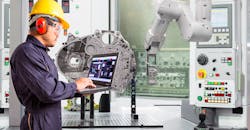Making the Decision to Automate CNC Machining
Automation can be a powerful tool for machine shops looking to streamline operations. Shop managers often leverage automation when they need to improve shop throughput, increase flexibility, or manufacture higher-quality parts. Different automation strategies will be necessary to secure these benefits, however.
Before adopting machine and finishing process automation, a machine-shop owner should have a solid understanding of what automation is meant to accomplish – like higher throughput, greater flexibility, improved finished-part quality, or some combination of these benefits. Depending on the particular benefits a shop wants to secure, different levels of automation and automation strategies may be necessary.
Know what to ask before automating
While deciding on which automation use-case will provide the greatest benefit, shop owners also should work to identify several key performance indicators (KPIs) or metrics that can be associated with each of these possible goals.
Gathering and analyzing a combination of several metrics — like scrap rates, the average number of tool assemblies, parts out the door per month, and cycle time —likely will be necessary to provide insight into how well automation is performing in a shop.
These metrics can help shop managers identify whether a new automation solution is providing the value they had anticipated — as well as the approximate ROI of their automation technology, and which solutions could provide additional benefits in the future.
Ideally, before the machine shop manager begins sourcing an automation solution, he or she should have a clear idea of how to integrate, measure, and track how automation impacts the shop’s ability to manufacture parts.
Shop owners experimenting with first-time implementations of automation projects also may want to prioritize simpler use-cases. Each automation project will provide data and experience that can help to make future projects easier to design and implement.
Once a shop owner has decided to seek the benefits of automation and knows how to measure the effectiveness of a particular implementation, he or she also should determine if the particular shop would benefit from adopting machine shop automation technology.
Before automating machining or finishing processes, manufacturers should determine if their facilities are ready for automation and if automation would provide a good return on investment.
Key considerations include worker training, whether the shop will adopt partial or full automation, environmental control, and current process consistency.
Implementing, maintaining automated CNC machines
Manufacturers can take advantage of different automation strategies depending on their particular needs.
For example, to automate a CNC lathe a shop may use a gantry robot to perform loading and unloading of the chuck. This robot may be supported by safety and maintenance systems like light curtains, safety fences, and automatic sensors capable of detecting tool breakage.
When a shop is manufacturing parts that require high levels of precision and there is very little room for error during the manufacturing process, these systems can be a way to both guarantee the safety of workers who operate or work near automated machines and help to meet the finished-quality standards.
For example, it’s not unusual for specialist machining shops to emphasize shop experience, advertise certification in ISO standards related to quality management, or otherwise emphasize business characteristics that may guarantee the high quality of parts.
Maintaining these standards or practices while integrating automation technology is critical. These automated safety and maintenance tools can help ensure that improving throughput does not come at the expense of part quality or shop scrap rate.
Another shop may adopt a flexible machine-tending robot arm that can manage both raw materials and finished parts.
Such automation approaches can be combined with best practices that help to improve machine shop efficiency — like tool upgrades, the use of multiple modes of operation, and the adoption of real-time management solutions — potentially increasing shop throughput.
Customized automation for finishing systems
For manufacturers or shops that want to automate finishing, custom-built automated mass finishing systems can streamline or fully automate these processes. A variety of automated finishing processes and related workflows, like vibratory finishing, centrifugal disc finishing, and magnetic separation, can be enabled with these systems.
As with other automation solutions, businesses that automate finishing will need both hardware and software. Selecting the right KPIs to track also will be important in determining whether the automated finishing system is providing quality results or improving the efficiency of shop manufacturing processes.
Automation to streamline operations
For machine shops wanting to boost productivity, improve part quality, or increase shop flexibility, automation can be a powerful tool. The high cost of adopting automation — which can require a significant investment of time and money — means careful planning will be necessary to get the best return out of a new automation system.
Automation systems for both machining and finishing processes are available, and both types will require a few of the same things — like KPIs that will help the shop estimate ROI and software that will allow the solution to be controlled by the shop’s or plant’s workers.
Emily Newton is the Editor-in-Chief of Revolutionized, an online magazine exploring the latest industrial innovations.
